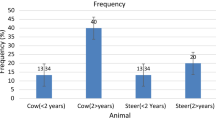Abstract
Crude oil pollution at drilling sites located within or in close proximity to agricultural pasture lands poses serious health risks to cattle raised on these lands. To investigate the clinical and systemic biochemical effects, cattle (8/group) were administered single oral doses of Pembina Cardium crude oil (PCCO) at 16.7, 33.4, and 67.4 g/kg, or water (control group) at 80 g/kg. Cattle exposed to PCCO showed dose-dependent clinical effects. At the lowest dosage, PCCO caused transient and minimal clinical effects; however, high dosages caused varied clinical signs which included tremors, nystagmus, vomiting, and pulmonary distress. On posttreatment day 7 or 30, four cattle from each treatment group were sacrificed and biochemical parameters were assayed in liver, lungs, and kidney cortex. In cattle monitored on posttreatment day 7, the PCCO-treated groups showed marked alterations from the control group in hepatic cytochrome P-450 (P-450), and in aryl hydrocarbon hydroxylase (AHH) and 7-ethoxycoumarin-O-deethylase (ECOD) activities of these tissues. Administration of PCCO caused significant increases (>100%) in hepatic P-450, but produced variable effects on AHH and ECOD activities in each tissue. The activity of AHH was increased in all tissues; however, the effect was highest in kidney cortex (>5000%), followed by liver (>500%) and lungs (>250%). The activity of ECOD was altered in a differential manner. It was either increased markedly (>1300%) in kidney cortex or increased slightly (20–30%) in liver, but decreased (>80%) in lungs. The activities of respiratory chain enzymes (succinate-cytochrome c reductase, NADH-cytochrome c reductase and cytochrome oxidase), or NADPH-cytochrome c reductase and glutathione tranferase were not changed significantly in any tissues. The alterations in P-450, AHH, and ECOD observed on day 7 were markedly reversed in cattle examined on day 30 posttreatment, indicating a recovery from induced changes. Studies in vitro with hepatic microsomal preparations from day 7 posttreatment groups showed that increases in AHH and ECOD activity in PCCO-treated cattle were due to induction of new isoforms of P-450, as evidenced by (1) the appearance of a 448-nm spectral peak, and (2) differential inhibitory effects of metyrapone and 7,8-benzoflavone on AHH and ECOD activities.
Similar content being viewed by others
References
Beach AC, Harmon HJ (1992) Additive effects and potential inhibitory mechanism of some common aromatic pollutants on in vitro mitochondrial respiration. J Biochem Toxicol 7:155–161
Burke MD, Orrenius S (1982) Isolation and comparison of endoplasmic reticulum membranes and their mixed function oxidase activities from mammalian extrahepatic tissues. In: Schenkman JB, Kupfer D (eds) Hepatic cytochrome P-450 monooxygenase system. Pergamon Press, New York, pp 47–97
Bystrom, JM (1989) Study on the acute toxicity of ingested crude petroleum oil to cattle. Master's thesis. University of Saskatchewan Department of Veterinary Pathology, Saskatoon, SK, Canada
Canadian Council on Animal Care (CCAC) (1980) Guide to the care and use of experimental animals. Vol 1. Ottawa, ON, Canada
Chaudhury S, Martin M, Payne JF, Rahimtula A (1987) Alterations in platelet aggregation and microsomal benzo-α-pyrene hydroxylase activities after exposure of rats to a Prudhoe Bay crude oil. J Biochem Toxicol 2:93–104
Edwards WC, Gregory DG (1991) Livestock poisoning from oil field drilling fluids, muds and additives. Vet Hum Toxicol 33:502–504
Edwards WC, Coppock RW, Zinn LL (1979) Toxicoses related to the petroleum industry. Vet Hum Toxicol 21:328–337
Gorsline J, Holmes WN, Cronshaw J (1981) The effects of ingested petroleum on the naphthalene-metabolizing properties of liver tissues in the sea-water adapted mallard ducks (Anus platyrhynchos). Environ Res 24:337–390
Johanneson KAM, DePierre JW (1978) Measurement of cytochrome P-450 in the presence of large amounts of contaminating hemoglobin and methemoglobin. Anal Biochem 86:725–732
Khan S, Rahimtula AD (1987) The role of heme metabolism during the induction of hepatic and renal cytochrome P-450 levels and drug-metabolizing enzymes in rats by a Prudhoe Bay crude oil. Can J Physiol Pharmacol 65:75–79
Khan S, Payne JF, Rahimtula AD (1986a) Mechanism of petroleum hydrocarbon toxicity: Functional changes in rat liver mitochondria after exposure to Prudhoe Bay crude oil. Toxicol Lett 32:141–146
Khan S, Rahman AH, Payne JF, Rahimtula AD (1986b) Mechanisms of petroleum hydrocarbon toxicity: Studies on the response of rat liver mitochondria to Prudhoe Bay crude oil and its aliphatic, aromatic and heterocycylic fractions. Toxicology 42:131–142
Khan AA, Coppock RW, Schuler MM, Sharma AK, Lillie LE (1989) Induction of hepatic cytochrome P-450 and xenobiotic metabolizing enzymes in rats gavaged with an Alberta crude oil. J Toxicol Environ Health 28:297–307
Khan AA, Schuler MM, Prior MG, Yong S, Coppock RW, Florence LZ, Lillie LE (1990) Effects of hydrogen sulfide exposure on lung mitochondrial respiratory chain enzymes in rats. Toxicol Appl Pharmacol 103:482–490
Lee YZ, Leighton FA, Peakall DB, Norstrom RJ, O'Brien PJ, Payne JF, Rahimtula AD (1985) Effects of ingestion of Hibernia and Prudhoe Bay crude oils on hepatic and renal mixed function oxidase in nestling herring gulls (Larus argentatus). Environ Res 36:248–255
Lee YZ, O'Brien PJ, Payne JF, Rahimtula AD (1986) Toxicity of petroleum crude oils and their effects on xenobiotic metabolizing enzyme activities in the chicken embryo in ovo. Environ Res 39:153–163
Longo V, Mazzacaro A, Naldi F, Gervasi PG (1991) Drug metabolizing enzymes in liver, olfactory, and respiratory epithelium of cattle. J Biochem Toxicol 6:123–128
Lowry OH, Rosebrough NJ, Farr AL, Randall RJ (1951) Protein measurement with the Folin phenol reagent. J Biol Chem 193:265–275
Montgomery DC (1991) Design and analysis of experiments, 3rd ed. John Wiley & Sons, New York
Morré DJ (1971) Isolation of Golgi apparatus. Met Enzymol XXII:130–148
Mustafa MG, Hacker AD, Ospital JJ, Hussain MZ, Lee SD (1977) Biochemical effects of environmental pollutants in animal lungs. In: Lee SD (ed) Biochemical effects of environmental pollutants. Ann Arbor Science, Ann Arbor, MI, pp 59–96
National Research Council (NRC) (1984) Nutrient requirements of beef cattle, 6th ed. National Academy Press, Washington, DC
Patel JM, Harper C, Drew RT (1978) The biotransformation of p-xylene to a toxic aldehyde. Drug Metab Disp 6:368–374
Paykkö K, Paavilainen S, Metsä-Ketlä T, Laustiola K (1987) The increasing and decreasing effects of aromatic hydrocarbon solvents on pulmonary and hepatic cytochrome P-450 in rat. Pharmacol Toxicol 60:288–293
Rabovsky J, Judy DJ (1989) The in vitro effects of alkanes, alcohols, and ketones on rat lung cytochrome P-450-dependent alkoxyphenoxazone dealkylase activities. Arch Toxicol 63:13–17
Rahimtula AD, Payne JF, Martin I (1982) Hydrocarbon-based oils as inducers of cutaneous aryl hydrocarbon hydroxylase. Toxicol Lett 10:213–217
Rahimtula AD, O'Brien PJ, Payne JF (1984) Induction of xenobiotic metabolism in rats on exposure to hydrocarbon-based oils. In: MacFarland HN, Holdsworth CE, MacGregor JA, Call RW, Lane ML (eds) Applied toxicology of petroleum hydrocarbons. Advances in modern environmental toxicology, Vol 6. Princeton Scientific Publishers Inc., Princeton, NJ, pp 71–79
Smith BR, Plummer JL, Wolf CR, Philpot RM, Bend JR (1992) p-Xylene metabolism by rabbit lung and liver and its relationship to the selective destruction of pulmonary cytochrome P-450. J Pharmacol Exp Therap 223:736–742
Walters P, Khan S, O'Brien PJ, Payne JF, Rahimtula AD (1987) Effectiveness of a Prudhoe Bay crude oil and its aliphatic, aromatic and heterocyclic fractions in inducing mortality and aryl hydrocarbon hydroxylase in chick embryo in ovo. Arch Toxicol 60:454–459
Author information
Authors and Affiliations
Rights and permissions
About this article
Cite this article
Khan, A.A., Coppock, R.W., Schuler, M.M. et al. Biochemical effects of pembina cardium crude oil exposure in cattle. Arch. Environ. Contam. Toxicol. 30, 349–355 (1996). https://doi.org/10.1007/BF00212293
Received:
Revised:
Issue Date:
DOI: https://doi.org/10.1007/BF00212293




